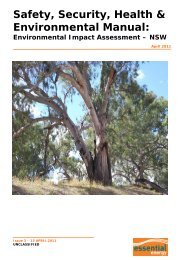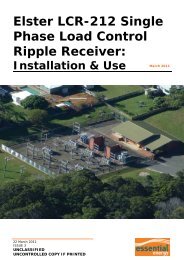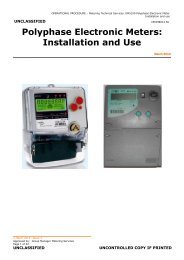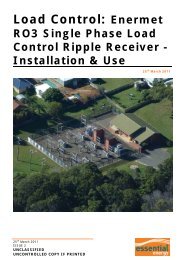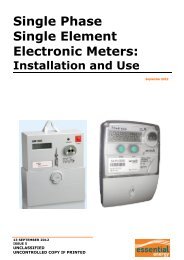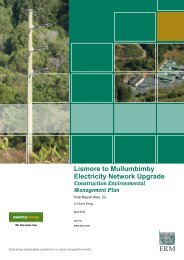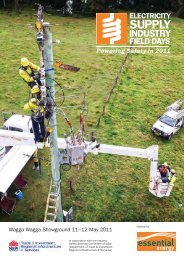CEOP8079 - Connection Guidelines - Essential Energy
CEOP8079 - Connection Guidelines - Essential Energy
CEOP8079 - Connection Guidelines - Essential Energy
Create successful ePaper yourself
Turn your PDF publications into a flip-book with our unique Google optimized e-Paper software.
UNCLASSIFIED<br />
OPERATIONAL PROCEDURE – <strong>Connection</strong> <strong>Guidelines</strong> for High<br />
Voltage <strong>Connection</strong>s and Embedded Generators<br />
<strong>CEOP8079</strong><br />
The results achieved from the test.<br />
Each test report must be:<br />
Signed and dated by the testing officer(s) and the witnessing officer<br />
Provided to <strong>Essential</strong> <strong>Energy</strong>.<br />
12.3.4 Commissioning Tests<br />
The <strong>Connection</strong> Applicant will produce a test plan to cover the commissioning requirements<br />
of all High Voltage assets and secondary equipment. This plan must identify testing<br />
responsibilities and actions for all parties and must be submitted for <strong>Essential</strong> <strong>Energy</strong>‟s<br />
agreement and approval. <strong>Essential</strong> energy must approve the commissioning program, final<br />
design and equipment requirements, prior to it being finalised by the <strong>Connection</strong> Applicant‟s<br />
ASP or its nominated representative.<br />
Commissioning tests will vary depending upon the type and make of equipment to be<br />
installed, the manufacturer‟s recommendations and <strong>Essential</strong> <strong>Energy</strong>‟s policies covering<br />
commissioning tests for zone substation equipment, secondary systems, HV transmission<br />
lines and cables.<br />
Final commissioning may also require phase identification, temporary protection schemes,<br />
service voltage testing, phasing out checks, protection directional checks and in-service<br />
balances and in-service metering checks.<br />
<strong>Essential</strong> <strong>Energy</strong> needs to ensure that all appropriate tests have been completed so that all<br />
HV equipment can be energised. This will require close cooperation between the ASP and<br />
<strong>Essential</strong> <strong>Energy</strong> employees. <strong>Essential</strong> <strong>Energy</strong> will also expect the <strong>Connection</strong> Applicant to<br />
rectify all defects found as a result of testing and checks by <strong>Essential</strong> <strong>Energy</strong> or others<br />
employed by the <strong>Connection</strong> Applicant. Any delay in defect rectification may impact on final<br />
commissioning which may, in turn, delay commissioning of other infrastructure owned by<br />
the <strong>Connection</strong> Applicant.<br />
Commissioning tests and checks to ensure compliance may include but not be limited to:<br />
Substations<br />
General compliance including civil and building works, secondary containment<br />
systems, fencing, public safety, security, fire protection systems, general layout of<br />
equipment<br />
Identification of equipment in accordance with <strong>Essential</strong> <strong>Energy</strong>‟s requirements<br />
Earth grid and earthing of equipment<br />
Conductivity and insulation testing<br />
HV disconnect and earthing switches<br />
HV circuit breakers<br />
HV current transformers<br />
HV voltage transformers<br />
Power transformers (including high voltage testing and On Load Tap Changer (OLTC)<br />
Protection schemes and associated secondary equipment<br />
Substation control systems<br />
Metering<br />
SCADA systems<br />
23 November 2012 - Issue 7<br />
Approved By: Group Manager Major Customer Engagement<br />
Page 24 of 36<br />
UNCLASSIFIED<br />
UNCONTROLLED COPY IF PRINTED




